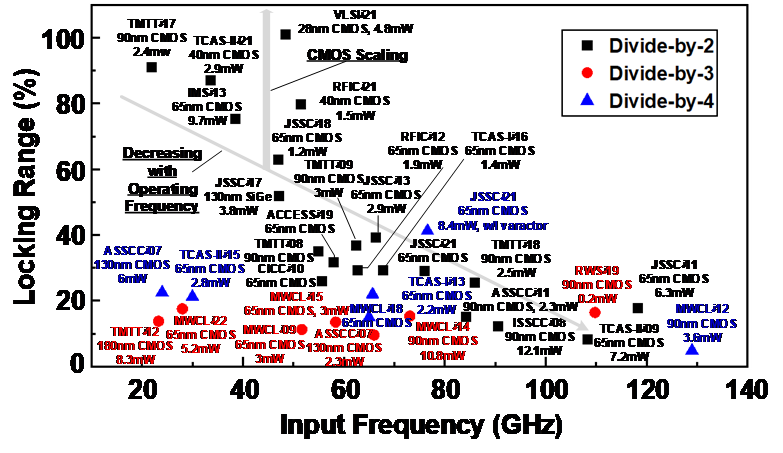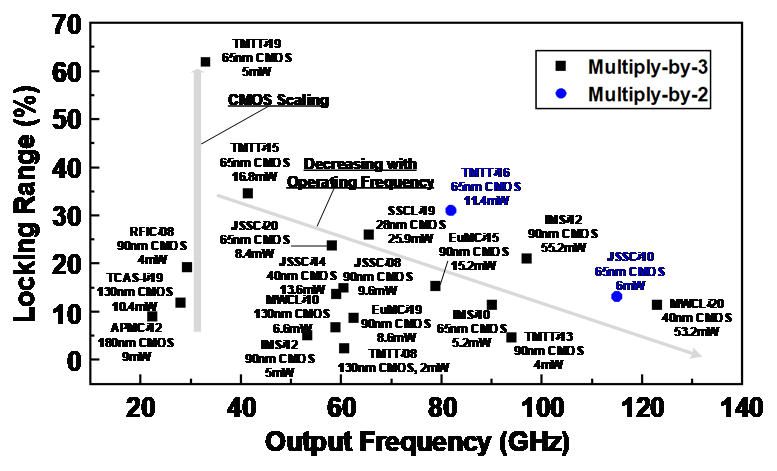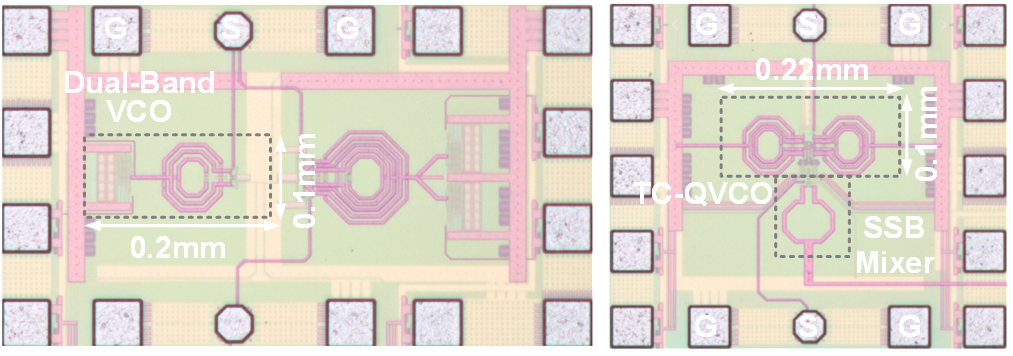Millimeter-wave (~24-to-300GHz) and terahertz (0.1-to-1THz) frequency bands have been gaining increasing attention due to their available wideband spectrum for various beneficial and emerging applications of high data-rate wireless/wireline communications and high-resolution imaging/sensing systems. Signal generators (e.g., Phase-Locked Loops, PLLs, and Oscillators) are among the essential building blocks for the operation of millimeter-wave and terahertz transceiver systems. A wideband signal generator with low phase noise and low power consumption is highly required to achieve a low transmitter error vector magnitude (EVM) and a high receiver signal-to-noise ratio (SNR).
Assistant Professor Xiaolong Liu’s research group from the School of Microelectronics (SME) at the Southern University of Science and Technology (SUSTech) has recently published a tutorial on injection-locking techniques for CMOS signal generation systems and their findings on their progress in designing high-performance millimeter-wave (mm-Wave) oscillators.
Their tutorial, entitled “Injection-locking techniques for CMOS millimeter-wave and terahertz signal generation,” was published in IEEE Transactions on circuits and systems II: Express Briefs (TCAS-II), an international peer-refereed top journal in the field of integrated circuits design.
At the same time, Prof. Liu’s team made significant progress in the design of high-performance mm-Wave oscillators. Their results, entitled “Analysis and design of magnetically tuned W-band oscillators”, have been published in IEEE Transactions on Very Large Scale Integration (VLSI) Systems.

Injection-locking techniques for CMOS mm-Wave and THz signal generation
With aggressive scaling of CMOS technologies, more and more integrated circuits (ICs) are designed and implemented in CMOS processes at millimeter-wave (mm-Wave) and terahertz (THz) frequencies for emerging applications.
For these applications, injection locking has been proved beneficial and promising because it can be used for phase noise reduction, frequency divisions/multiplications at high mm-Wave/THz frequencies with low power consumption, synchronization of elements in arrays, and high-sensitivity power detection. Based on the injection-locking techniques, state-of-the-art performance has been achieved by sub-harmonic injection-locked phase-locked loops (IL-PLLs) with ultra-low phase noise and wide tuning range, injection-locked frequency dividers (ILFDs), and injection-locked frequency multipliers (ILFMs) with wide locking range and low power consumption.
Firstly, this paper summarizes the working principle of injection-locking and reveals the way to realize ILFDs or ILFMs through injection-locked oscillators (ILOs). In addition, it presents a comprehensive tutorial on the recent works of wide locking-range mm-Wave/THz ILFDs (Figure 1) and ILFMs (Figure 2), summarizes the highlights of various technologies, and prospects for the development trend in the future.
This study analyzes the advantages of mm-Wave/THz subharmonic IL-PLLs over the traditional fundamental PLL and introduces the frequency tracking technology applied to the IL-PLLs.

Figure 1. Performance comparison of mm-Wave ILFDs

Figure 2. Performance comparison of mm-Wave ILFMs
Analysis and design of magnetically tuned W-band oscillators
In this research work, Prof. Liu’s group proposed a new transformer-based magnetic tuning technique without using low-quality varactors for the design of fully integrated oscillators with operating frequencies above 100GHz. It includes coarse tuning and fine-tuning, corresponding to the traditional switching capacitor tuning and varactor tuning, respectively.
Two W-band mm-Wave oscillators with a wide frequency tuning range, low phase noise, and low power consumption were designed and implemented in a 65-nm CMOS process. This study provides a practical solution for the design of magnetically tuned mm-Wave oscillators and has important application value.
In addition, due to the significant contributions to the development of the magnetic-tuning mm-Wave/THz oscillators by the research group, Prof. Liu was invited as a keynote speaker in the session of “RF/mmW VCOs” to present his work at the premier international conference 2019 IEEE Custom Integrated Circuits Conference (CICC).

Figure 3. Die micrographs of the proposed mm-Wave oscillators
Prof. Xiaolong Liu from SME at SUSTech is the first and the only corresponding author of these two papers. SUSTech is the first unit of the paper. These works were supported by the SUSTech Startup Matching Fund and the Hong Kong General Research Fund.
Paper links:
IEEE Transactions on Circuits and Systems II: Express Briefs (TCAS-II): https://ieeexplore.ieee.org/document/9779872
IEEE Transactions on Very Large Scale Integration (VLSI) Systems: https://ieeexplore.ieee.org/document/9741242
To read all stories about SUSTech science, subscribe to the monthly SUSTech Newsletter.
Proofread ByAdrian Cremin, Yingying XIA
Photo By